- Introduction
- Nathan Fabian on aim of the TEG Expert Group and Taxonomy
- Examples of specific thresholds
- Questions and Answers
- Discussion
.@ClimateBonds EU Taxonomy Explored: A Talk with TEG Experts @seankidney @BNPPAM_COM @nathanafabian @PRI_News started. https://t.co/fQV63XRG6j
Introduction
[1] Introduction @seankidney
Panelists:
Nathan Fabian @PRI_News Helena Viñes Fiestas @BNPPAM_COM
- Overview / teaser session, not details. Questions are welcome.
- 9-week weekly deep dives are planned.
Reiterates the need of rethink our economy due to #COVID2019 https://t.co/i77p6FNT6J
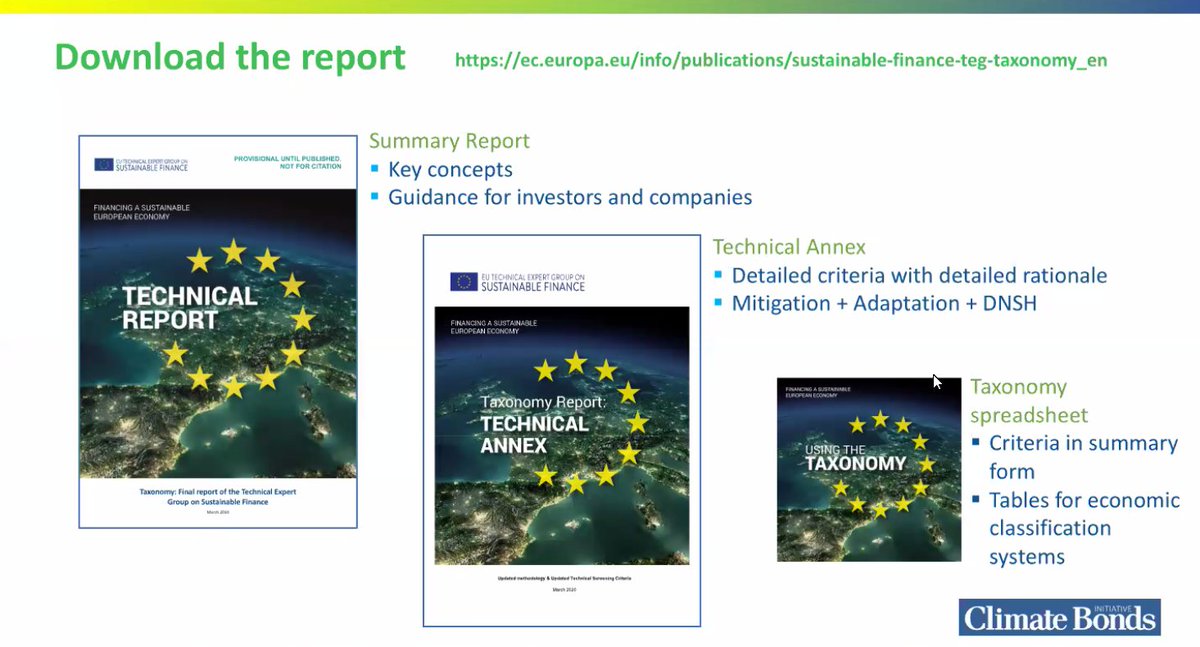
Nathan Fabian on aim of the TEG Expert Group and Taxonomy
[2] Nathan Fabian @PRI_News
Aim of high level expert group on taxonomy: list of activities with environmental performance standards.
3 weeks ago: recommendations of criteria have been updated. 1000’s of technical responses have been submitted.
Published in march ⬇️ https://t.co/dqYMmjeiBp
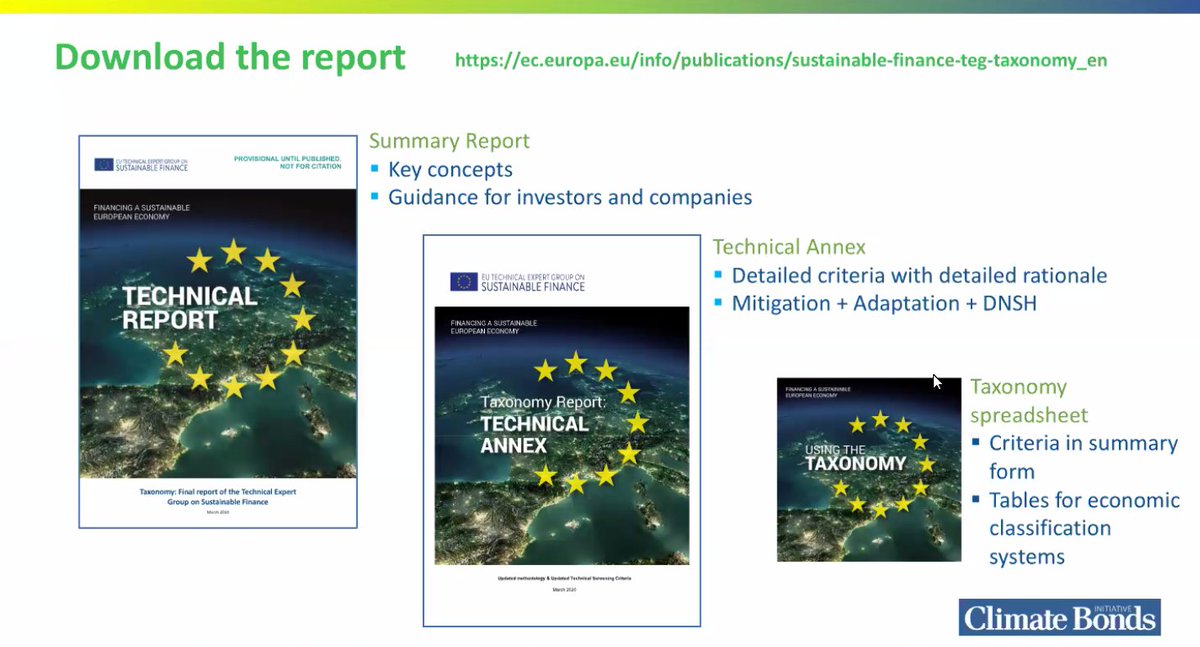
Report contains detailed explanations, but there is a spreadsheet available with per-activity standard values and criteria.
What has changed since June 2019?
- Update of mitigation criteria
-
Adaptation criteria for 68 activities (significant harm assessment update)
- Guidance for companies on how to use the taxonomy
- How could international taxonomy look like?
- Prospect on how to develop the taxonomy in the future.
[2bis] 4 different layers in the taxonomy, including enabling/contributing sectors
Helena @BNPParibas : “Traditional taxonomies do not include transition sectors. Don’t know where to set the bar, we could be accused of greenwashing. By including, we expand scope of investment.” https://t.co/HosuWEtaJp
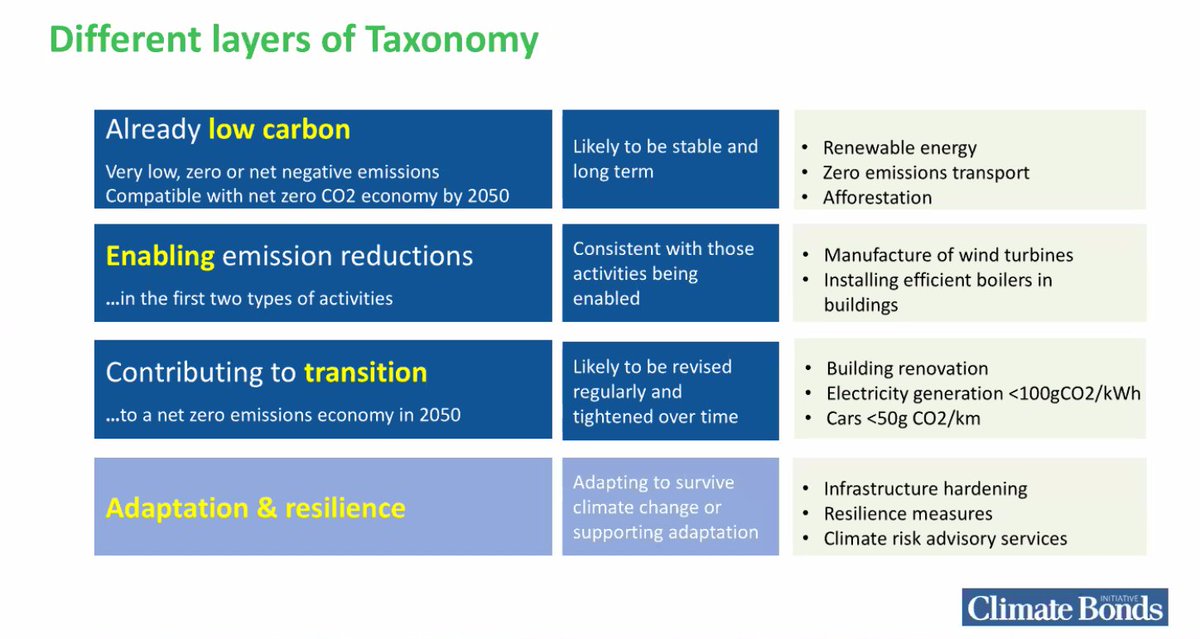
Nathan Fabian @PRI_News: Transition = towards destination / endpoint.
Taxation sets criteria and thresholds for transition. If we don’t reduce fast enough, we need to rely on negative emissions which are hard to deploy on time and scale. https://t.co/HT7VfBR235
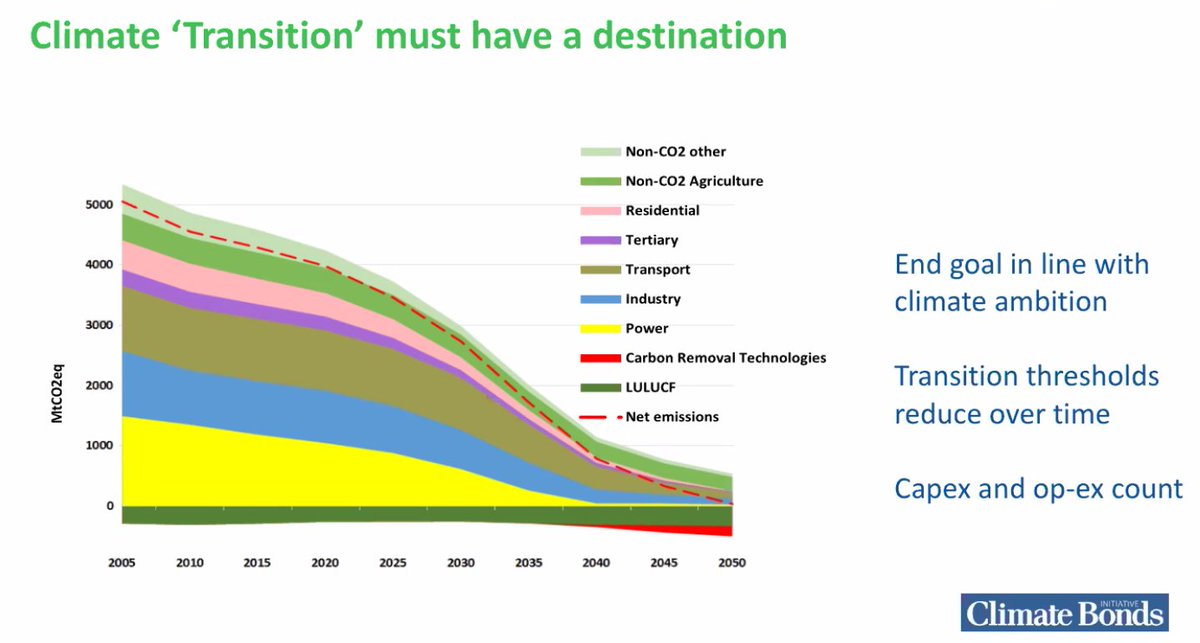
Examples of specific thresholds
[3] Examples of specific thresholds by @seankidney
- No new unabated fossil fuels. We were long told that gas is a transition fuel. But the science has changed, as a result of not doing enough en not listening to scientists. https://t.co/kUfvGeyuIs
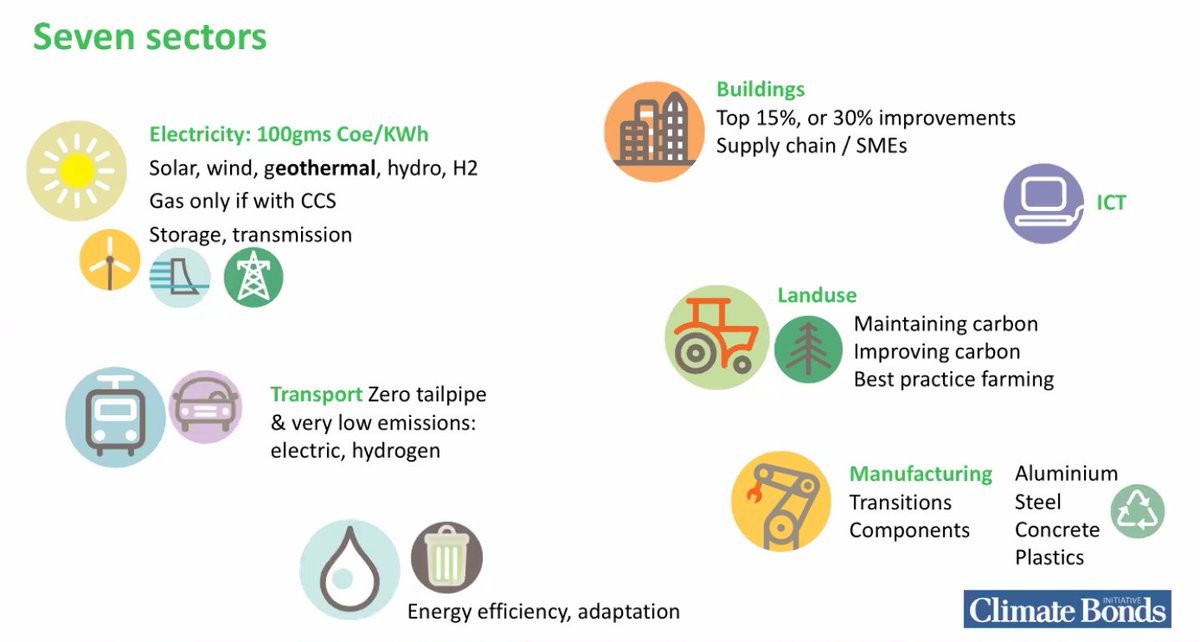
- Proposed threshold: 100 gCO2/kWh.
💡Note 1 : NGOs call for 50 gCO2 instead of 100 .
💡Note 1 : @EIB currently uses a threshold of 250 gCO2.
See thread with background info:
Building sector
For buildings - 3 types of thresholds:
- Renovation
- New houses
- Ownership and acquisition threshold: lending to buy an existing house. You need to be in top 20 % of top-performers of market. We did not consider specific thresholds, it is problematic to take this step. … https://t.co/bnBiSH4zqd

… we asked the @EU_Commission to work further on this. We ask investors to give strong arguments to need threshold of meeting top 20 % threshold of the market.
New zero-energy standards of @EU_Commission are quite ambitious. All new public sector buildings will need to comply.
Nathan Fabian @PRI_News : “Embodied emissions of buildings should be also included. This means a net negative emission value for houses”.
Land use sector
“Some sectors have qualitative criteria, such as the land use sectors, as the practices differ widely across Europe”
Manufacturing sector
Nathan Fabian @PRI_News: “For manufacturing, we widely used existing EU ETS benchmarks. We know the investments required are enormeous to maintain a good emission performance. This is the industrial economy, including jobs and economic productivity. …
Forestry
Nathan Fabian @PRI_News: “I hope we caught the nuances in different forestry management practices in Europe”
“We tried to use frameworks that already are in use. They respond to ways that different industries are used to reporting and measuring environmental performance”
“For examples, for the building sectors we built further on energy certificates. This is the reason for differences, but I hope it makes sense”
@seankidney : “We have been guided by ETS benchmarks, but these are not endpoints. For example, we see zero-emission steel in Sweden, and China is also planning to built those. I think we need to tighten these criteria rather quickly”
Steel industry
@seankidney : “How can we work with the steel industry, and ensure that sufficient green hydrogen is available for production?”
“For the cement industry: we already see products on offer with -70/80 % emissions compared to mainstream cement.”
@seankidney : “On cement: new tech is currently more expensive, but if it gets scaled up it can get cheaper quickly. Can we get @EU_Commission countries to collaborate to make this happen? Scientists tell: there is no choice, we absolutely need to get emissions down”
Questions and Answers
Question: does the taxonomy address social issues?
Helena @BNPParibas : “Taxonomy operates at activity level, not at company level. We need to look at how activities are conducted. For this, we can use the @OECD guidelines.”
Question from myself: did you consider an earlier net zero target (before 2050) ?
(in context of carbon budgets : https://t.co/7kSUFoFkmc)
@seankidney : currently using EU targets/framework. From a personal opinion, I think we need to do better. But it’s a good starting point.
Discussion
Reporting obligations
Helena @BNPParibas : ‘companies will be obligated to report the link with the Taxonomy, and to which extent the OPEX/CAPEX are in lign with the taxonomy. At the moment, it is only a reporting obligation”.
“One of the characteristics is that the taxonomy works bottom-up. You need to look at different installations. Only revenues generated at the specific plant can be taken into consideration.” https://t.co/i5wJ8E5KnD
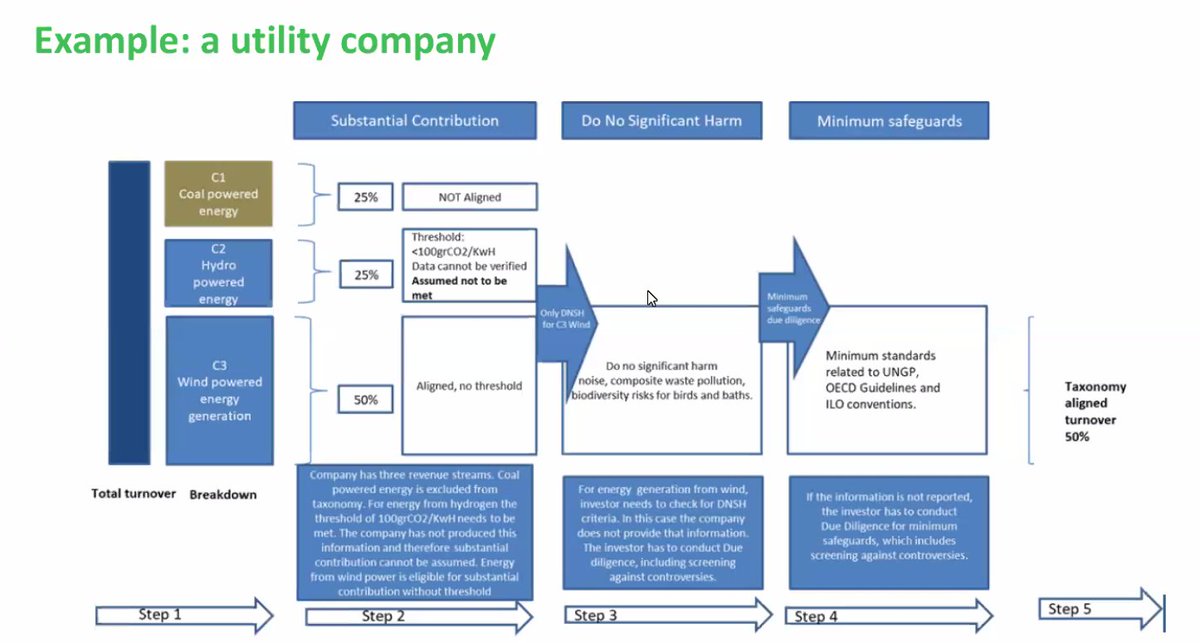
“Taxonomy is going to allow us to get a clear picture of companies, and see which operations are in line and which are not.”
“It is first and foremost a measurement tool.”
“For example: a cement company. To what extent the taxonomy check is going to influence investment decisions? I think there is going to be a lot of incentive to respond to it, as other investors will be using the same tool and taxonomy to construct portfolio’s.”
Practical advice for investors
@seankidney : “What would be a practical advice for investors who want to apply the taxonomy?”
Helena @BNPParibas : “In the final political agreement on the taxonomy, all companies that fall under the scope of the non-financial reporting directive need to report on the taxonomy”
“Read the summary report.”
“You need to take the percentage of turnover that is in line with the taxonomy. For equities, we think it is better to turnover, but also CAPEX can be used. For example, if you want to have a forward looking insight”.
“The exercise is less simple for those that fall out of the scope of the non-financial reporting directive. For those we have a 5-step procedure. But when they can’t disclose or can’t prove criteria, they can disclose ‘potential alignment’ of specific parts of company” https://t.co/2uhCM609AR
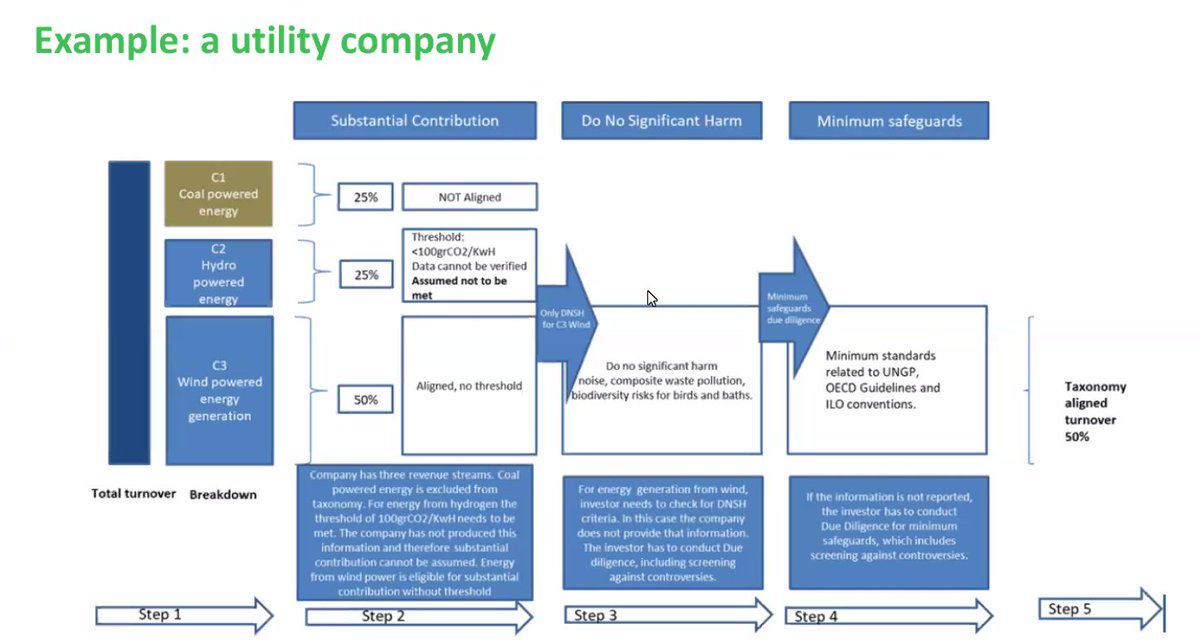
Link with COVID19
@seankidney : “Is the #COVID2019 cause a stall of ambitions or rather cause stronger ambitions?”
Nathan Fabian @PRI_News: “This is a critical moment, and we should not waste it. If we wait another 10 years, it is too late”